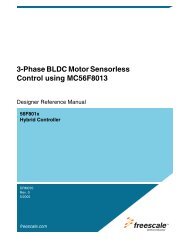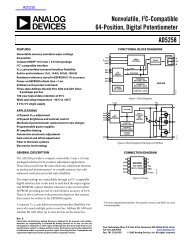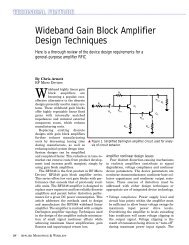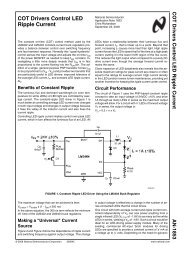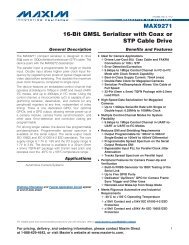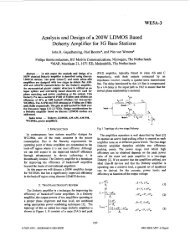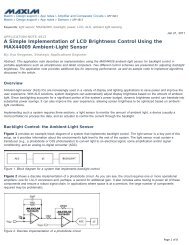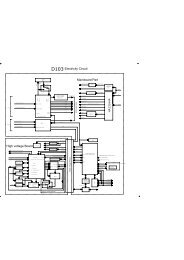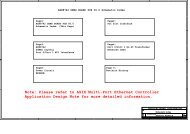A Multi-Carrier UHF Passive RFID System
A Multi-Carrier UHF Passive RFID System
A Multi-Carrier UHF Passive RFID System
Create successful ePaper yourself
Turn your PDF publications into a flip-book with our unique Google optimized e-Paper software.
Figure 3 [2]. Let s () t denote the output of the circuit<br />
as presented in Eq.(8).<br />
e<br />
e<br />
2 2<br />
() = () + + 2 () cos( 2π∆ + φ()<br />
)<br />
s t m t A Am t ft t<br />
.(8)<br />
Utilizing the Taylor series, se<br />
() t can be expanded as<br />
Eq.(9).<br />
2 2 1<br />
⎡2Am () t cos( 2π∆ ft + φ()<br />
t ) ⎤<br />
Se<br />
() t = A + m () t i{1 + ⎢<br />
⎥<br />
2 ⎢<br />
2 2<br />
⎣<br />
A + m () t ⎥<br />
⎦<br />
2<br />
1<br />
⎡2Am() t cos ( 2π∆ ft + φ()<br />
t ) ⎤<br />
− ⎢<br />
⎥ + remainders}<br />
8<br />
2 2<br />
⎢<br />
⎣<br />
A + m () t ⎥<br />
⎦<br />
.(9)<br />
se<br />
() t is then passed through the LPF as depicted in<br />
Figure 3. Assuming ∆f<br />
is sufficiently large; the high<br />
frequency terms are filtered by the LPF. The<br />
output se<br />
() t can be approximated as Eq.(10).<br />
2 2 1<br />
se<br />
() t = A + m () t −<br />
. (10)<br />
2 2<br />
4 A + m () t<br />
As shown in experimental results, the R-T<br />
command can be correctly recognized by Gen2 tags<br />
under such a circumstance. Contradictorily, when ∆ f<br />
is small, the R-T command is distorted by the CW<br />
emitted by the CWE, and Gen2 tags do not respond the<br />
command.<br />
2.2. The modulation depth of R-T commands<br />
In [1], the modulation depth (MD) of a valid R-T<br />
command is specified to be greater than 80% and less<br />
than 100% in terms of the incident electric field<br />
strength at the tags. The MD is defined as Eq.(11).<br />
EA<br />
− EB<br />
MD = , (11)<br />
EA<br />
where E<br />
A<br />
and E<br />
B<br />
denote the maximum and<br />
minimum amplitudes of the RF envelope in an R-T<br />
command respectively. Figure 4(a) and Figure 4(b)<br />
illustrate an R-T command in an ordinary Gen2 system<br />
and in the proposed system respectively. From Eq.(10)<br />
and Eq.(11), the MD in our proposed system can be<br />
2 2 2 2<br />
A + A − A / A + A .For the<br />
presented as ( t )<br />
typical MD=90%, the power relation between the CWE<br />
and the transceiver can be derived as Eq.(12).<br />
t<br />
P / d + P / d − P / d<br />
' ' '<br />
cw 1 tx 2 cw 1<br />
'<br />
'<br />
Pcw<br />
/ d1+<br />
Ptx<br />
/ d2<br />
= 90% , (12)<br />
'<br />
where P<br />
tx<br />
denotes the maximum transmission power<br />
of the transceiver while sending an R-T command.<br />
2.3. The detection symbol in R-T Commands<br />
In order to decode an R-T command, the tag IC must<br />
have a PIE decoder, which is an edge detector [2]. A<br />
regular Gen2 R-T command cannot be directly used in<br />
the proposed system, because the first falling edge and<br />
the last rising edge of the R-T command, as depicted in<br />
Figure 4(a), cannot be detected by tags. In order to be<br />
compliant with Gen2 tags, two short detection symbols<br />
are added to the head and the tail of each R-T<br />
command in the proposed system as illustrated in<br />
Figure 4(b).<br />
3. Experimental results<br />
An Agilent 89601 vector signal analyzer<br />
incorporating with an Agilent E4445A spectrum<br />
analyzer is used to capture the communication signals<br />
between the transceiver and a Gen2 tag. The<br />
frequencies of the CWE and the transceiver are<br />
915MHz and 917MHz respectively. The R-T Tari is<br />
25us, and the duration of the both detection symbols<br />
are 11us. The powers of the CWE and the transceiver<br />
are adequately adjusted, so that the MD requirement is<br />
satisfied. The snapshots are taken nearby the tags.<br />
Figure 5 shows that the tag MBS is relatively strong.<br />
Under such a circumstance, the accessible range of the<br />
tag can be extended to 4 times longer than that of an<br />
ordinary Gen2 system with the same emission power.<br />
Figure 6 demonstrates an interesting multi-band<br />
backscatter property of Gen2 tags. We let the<br />
transceiver not only send the R-T commands but also<br />
send a low power CW during the tag responses. We<br />
found that the tag MBS presents not only in the carrier<br />
frequencies of CWE but also in the carrier frequencies<br />
of the transceiver (917MHz) as illustrated in Figure 6.<br />
This phenomenon implies that we can apply the<br />
frequency diversity technology (using a multi-carrier<br />
CWE, for instance) to enhance the quality of the tag<br />
MBS and to mitigate the multipath fading problem.<br />
4. Conclusion<br />
In this paper, we proposed a multi-carrier <strong>UHF</strong><br />
passive <strong>RFID</strong> <strong>System</strong>, which can effectively extend the<br />
accessible range of Gen2 tags. Moreover, the multiband<br />
backscatter property of Gen2 tags, which is<br />
Proceedings of the 2007 International Symposium<br />
on Applications and the Internet Workshops (SAINTW'07)<br />
0-7695-2757-4/07 $20.00 © 2007


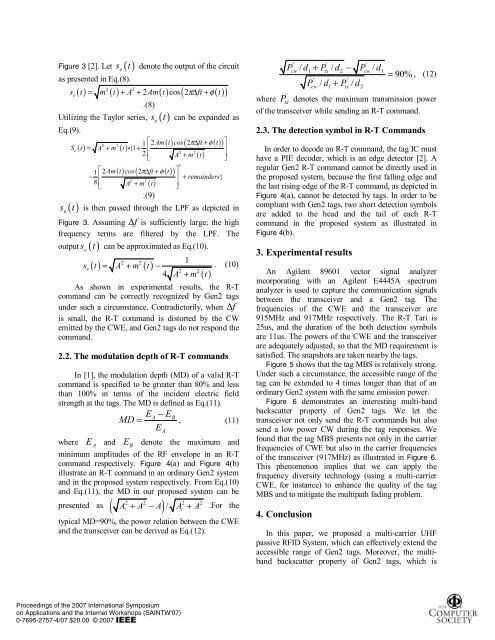
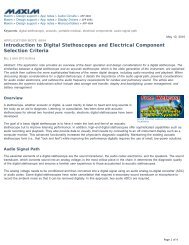
![P-CAD EDA - [Sheet1]](https://img.yumpu.com/49470492/1/190x115/p-cad-eda-sheet1.jpg?quality=85)
